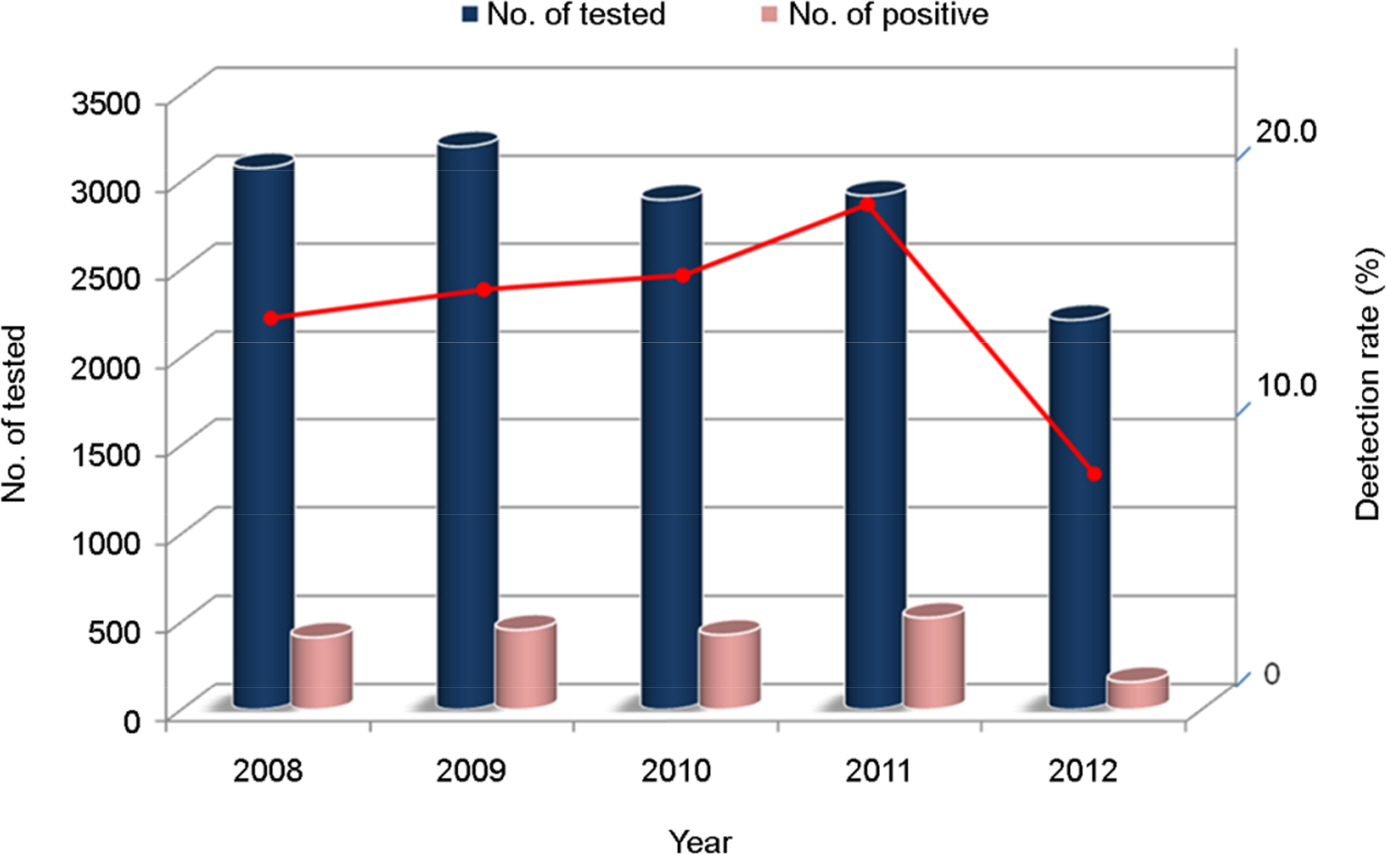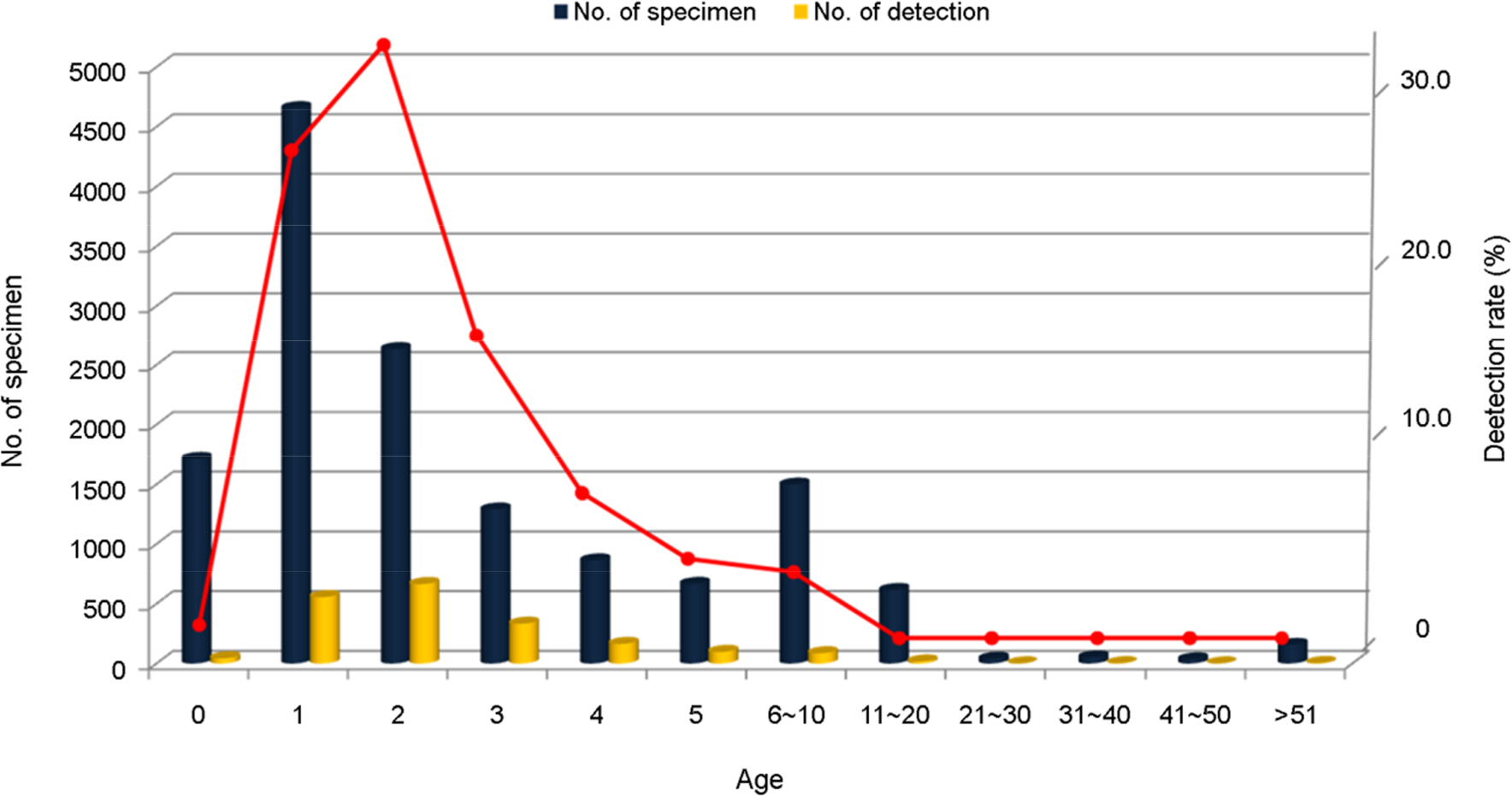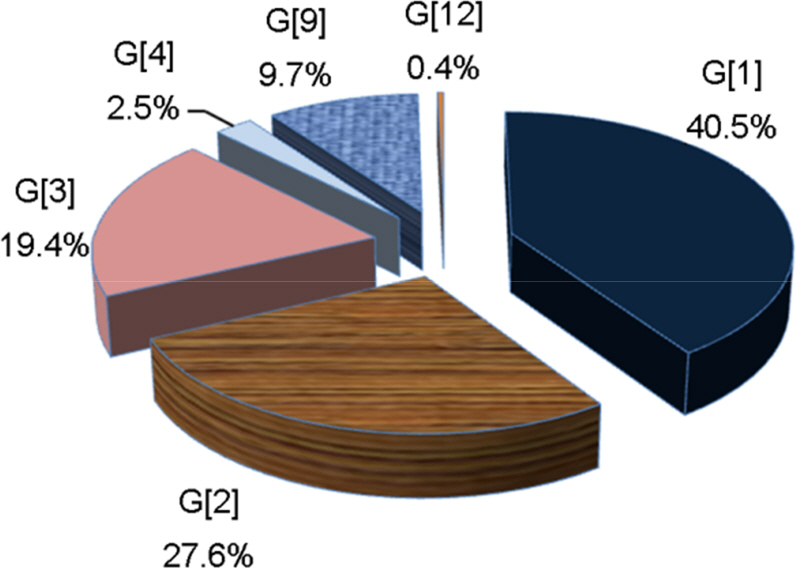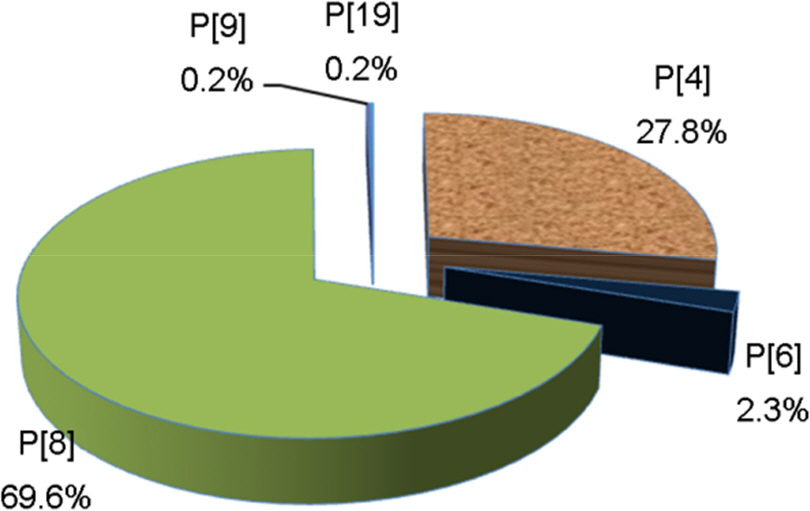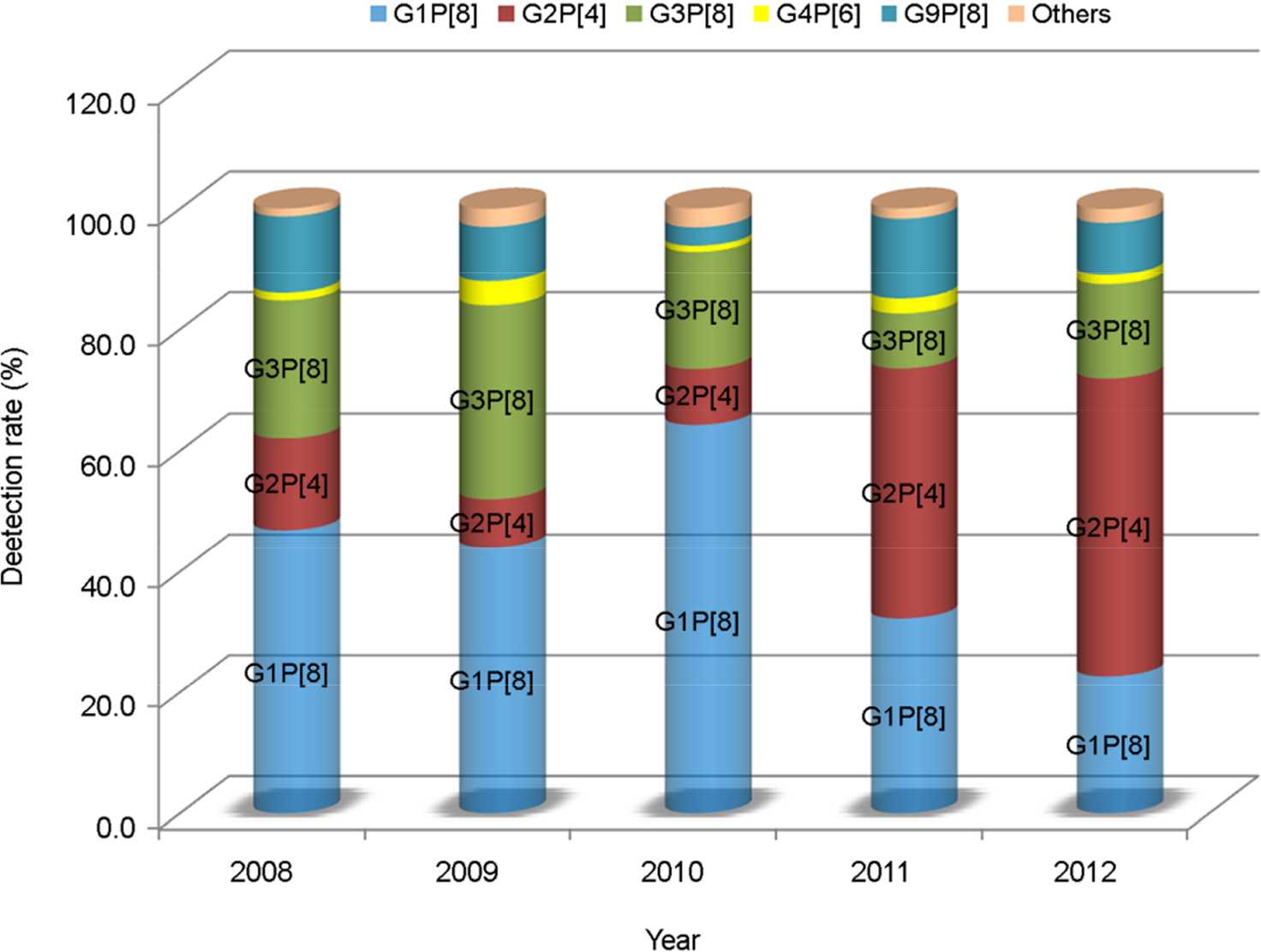J Bacteriol Virol.
2014 Jun;44(2):197-205. 10.4167/jbv.2014.44.2.197.
The Molecular Epidemiology of Circulating Group A Rotavirus in Gwangju Metropolitan City, Korea: 2008~2012
- Affiliations
-
- 1Health and Environment Institute of Gwangju, Korea.
- 2National Institute of Health, Korea Centers for Disease Control and Prevection, Chungcheongbuk-do, Korea.
- 3College of Veterinary Medicine, Chonnam National University, Gwangju, Korea. bjlee@chonnam.ac.kr
- KMID: 2168695
- DOI: http://doi.org/10.4167/jbv.2014.44.2.197
Abstract
- Group A rotaviruses are a major cause of acute gastroenteritis in young children worldwide. For the proper management of rotavirus infections, knowledge of the distribution of G and P genotypes including detection of emerging genotype is crucial. Therefore, the aim of this study is to describe epidemiological changes in rotavirus gastroenteritis in Gwangju metropolitan city, South Korea. Stool samples were collected from 14,314 patients with diarrhea, who visited hospitals in Gwangju from 2008 to 2012. Samples were screened for rotavirus with Enzyme-Linked Immunosorbent Assay (ELISA) method and rotavirus P (VP4), G (VP7) genotypes were determined by reverse-transcription polymerase chain reaction. And we performed nucleotide sequencing analysis. Among a total of 14,314 samples investigated 1,982 samples (13.8%) were ELISA positive. Genotyping of Rotavirus was performed using 526 rotavirus samples. The most prevalent circulating G genotype was G1 (40.5%), followed by G2 (27.6%), G3 (19.4%), G9 (9.7%), G4 (2.5%) and G12 (0.4%). The predominant type of P genotypes was P[8] (69.6%), followed by P[4] (27.8%) and P[6] (2.3%). In this study, 13 G-P combinations were detected. From 2008 to 2010, G1P[8] was the most prevalent, followed by G3P[8]. Whereas, 2011 and 2012, G2P[4] was the most common, followed by G1P[8]. Rotavirus gastroenteritis is a common disease associated with significant morbidity, mortality and economic burden. Ongoing rotavirus surveillance to understand the distribution of G and P genotypes will be critical for the development of effective prevention measurements.
Keyword
MeSH Terms
Figure
Reference
-
1). Kapikian AZ, Flores J, Midthun K, Hoshino Y, Green KY, Gorziglia M, et al. Strategies for the development of a rotavirus vaccine against infantile diarrhea with an update on clinical trials of rotavirus vaccines. Adv Exp Med Biol. 1989; 257:67–89.
Article2). Parashar UD, Burton A, Lanata C, Boschi-Pinto C, Shibuya K, Steele D, et al. Global mortality associated with rotavirus disease among children in 2004. J Infect Dis. 2009; 1:S9–S15.
Article3). Estes MK, Kapikian AZ, Knipe DM, Griffin DE, Lamb RA, Straus SE, et al. Rotaviruses. Fields. Virology. Fifth ed.Philadelphia: Lippincott Williams & Wilkins;2007. p. 1917–74.4). Ciarlet M, Estes MK. Interactions between rotavirus and gastrointestinal cells. Curr Opin Microbiol. 2001; 4:435–41.
Article5). Gorziglia M, Larralde G, Kapikian AZ, Chanock RM. Antigenic relationships among human rotaviruses as determined by outer capsid protein VP4. Proc Natl Acad Sci U S A. 1990; 87:7155–9.
Article6). Green KY, Sears JF, Taniguchi K, Midthun K, Hoshino Y, Gorziglia M, et al. Prediction of human rotavirus serotype by nucleotide sequence analysis of the VP7 protein gene. J Virol. 1988; 62:1819–23.
Article7). Matthijnssens J, Ciarlet M, McDonald SM, Attoui H, Bányai K, Brister JR, et al. Uniformity of rotavirus strain nomenclature proposed by the Rotavirus Classification Working Group (RCWG). Arch Virol. 2011; 156:1397–413.
Article8). Barnett B. Viral gastroenteritis. Med Clin North Am. 1983; 67:1031–58.
Article9). Ansari SA, Springthorpe VS, Sattar SA. Survival and vehicular spread of human rotaviruses: possible relation to seasonality of outbreaks. Rev Infect Dis. 1991; 13:448–61.
Article10). Santos N, Hoshino Y. Global distribution of rotavirus serotypes/genotypes and its implication for the development and implemention of an effective rotavirus vaccine. Rev Med Virol. 2005; 15:29–56.11). Gentsch JR, Glass RI, Woods P, Gouvea V, Gorziglia M, Flores J, et al. Identification of Group A rotavirus gene 4 types by polymerase chain reaction. J Clin Microbiol. 1992; 30:1365–73.
Article12). Gómara MI, Cubitt D, Desselberger U, Gray J. Amino acid substitution within the VP7 protein of G2 rotavirus strains associated with failure to serotype. J Clin Microbiol. 2001; 39:3796–8.
Article13). Choe YJ, Yang JJ, Park SK, Choi EH, Lee HJ. Comparative Estimation of Coverage between National Immunization Program Vaccines and Non-NIP Vaccines in Korea. J Korean Med Sci. 2013; 28:1283–8.
Article14). Brandt CD, Kim HW, Rodriguez WJ, Arrobio JO, Jeffries BC, Parrott RH. Rotavirus gastroenteritis and weather. J Clin Microbiol. 1982; 16:478–82.
Article15). Seo JK, Sim JG. Overview of rotavirus infections in Korea. Pediatr Int. 2000; 42:406–10.
Article16). Suzuki H, Sakai T, Tanabe N, Okabe N. Peak rotavirus activity shifted from winter to early spring in Japan. Pediatr Infect Dis J. 2005; 24:257–60.
Article17). Konno T, Suzuki H, Katsushima N. Influence of temperature and relative humidity on human rotavirus infection in Japan. J Infect Dis. 1983; 147:125–8.
Article18). Kim SH, Cheon DS, Jeong HS, Kim MJ, Kee HY, Seo JJ, et al. Distribution of group A rotavirus genotypes circulating in Gwangju, Korea. J Bacteriol Virol. 2009; 39:21–8.
Article19). Choi HJ, Oh BY, Lee MY, Koh YJ, Gong YW, Hur MJ, et al. The prevalence and distribution of the P and G Genotypes of a group A rotavirus detected in acute gastroenteritis patients from Incheon. J Life Sci. 2012; 22:600–4.
Article20). Shim JO, Thai Than V, Ryoo E, Lim I, Yoon Y, Kim K, et al. Distribution of Rotavirus G and P genotypes approximately two years following the introduction of rotavirus vaccines in South Korea. J Med Virol. 2013; 85:1307–12.
Article21). Kargar M, Akbarizadeh AR. Prevalence and molecular genotyping of group A rotaviruses in Iranian children. Indian J Virol. 2012; 23:24–8.
Article22). Ahmed MU, Alam MM, Chowdhury NS, Haque MM, Shahid N, Kobayashi N, et al. Analysis of human rotavirus G serotype in Bangladesh by enzyme-linked immunosorbent assay and polymerase chain reaction. J Diarrhoeal Dis Res. 1999; 17:22–7.23). Saravanan P, Ananthan S, Ananthasubramanian M. Rotavirus infection among infants and young children in Chennai, South India. Indian J Med Microbiol. 2004; 22:212–21.
Article24). Kapikian AZ, Hoshino Y, Chanock RM. Rotaviruses. Fields Knipe DM, Howley RM, Griffin DE, editors. Virology. Philadelphia: Lippincott Williams and Wilkins;2001. p. 1787–825.25). Gentsch JR, Laird AR, Bielfelt B, Griffin DD, Banyai K, Ramachandran M, et al. Serotype diversity and reassortment between human and animal rotavirus strains: implications for rotavirus vaccine programs. J Infect Dis. 2005; 192:146–59.
Article26). Kim EJ, Kim MS, Chae YZ, Cheon DS. Genotype of grouop A rotavirus isolated in acute gastroenteritis patients and groundwater in Seoul, Korea. Kor J Microbiol. 2011; 47:323–7.
- Full Text Links
- Actions
-
Cited
- CITED
-
- Close
- Share
- Similar articles
-
- Diversity of Rotavirus Strain Circulated in Gwangju, Republic of Korea
- Antigen Distributions of Rotavirus and Adenovirus Detected by Enzyme Immuno Assay (EIA) from Acute Gastroenteritis Patients in Seoul
- Rotavirus Vaccine
- Distribution of Group A Rotavirus Genotypes Circulating in Gwangju, Korea
- The Genetic Diversity of Norovirus from Children with Diarrhea in Gwangju Metropolitan City, Korea: 2008-2012

